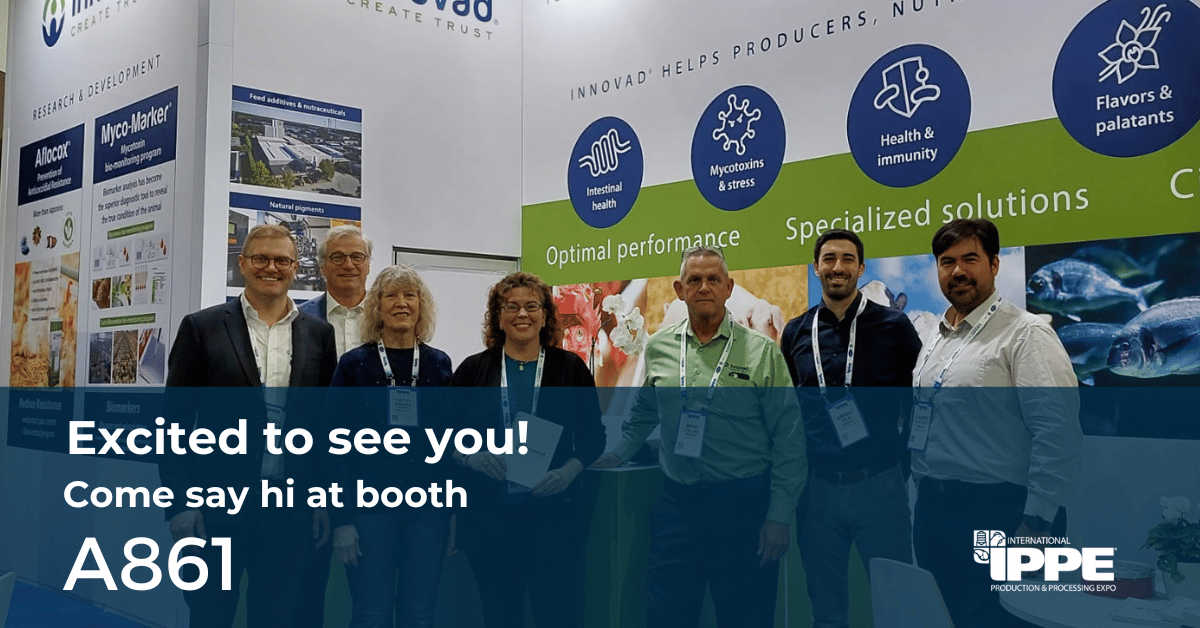Innovad is set to reveal a unique in vivo technology that offers the opportunity to more accurately assess mycotoxin exposure and mitigation strategies in the poultry industry during a TECHTalk at the International Production & Processing Expo (IPPE). Dr. Michael Lilburn, Professor Emeritus of The Ohio State University, will present "The Application of Blood Biomarker Technology to Mycotoxin Awareness and Mitigation" on Thursday, February 1, at 12:30, on the TECHTalk stage in booth A244.
Recent work has led to a scientifically validated in vivo technology using blood biomarkers to directly assess the level of mycotoxin exposure. This is a new generation tool that, when combined with feed analysis, gives poultry producers a complete assessment of their mycotoxin risk or mitigation program. Dr. Michael Lilburn will review the development and application of this protocol, Myco-Marker™, as well as the value that users have found in the information it provides during the TECHTalk
Navigating mycotoxin mitigation: innovations and advancements
Commercial mycotoxin mitigation products seek to efficiently bind toxins or modify their structure for reduced intestinal absorption. While these proprietary blends claim to reduce exposure to various toxins, the market currently offers only one in vivo assessment tool, directly sampling live birds and animals, to monitor mitigation program effectiveness.
In understanding mycotoxins, it's crucial to recognize that the circulating form of a toxin may be the intact toxin itself, or more commonly, post-absorptive metabolites known as "biomarkers", that reflect the absorption and metabolic transformation of individual toxins. These blood biomarkers vary across species – for instance, DON-sulfate in poultry and DON-glucuronide in swine. The European Food Safety Agency (EFSA) advocates for biomarker use to evaluate proposed mycotoxin "detoxifier" products.
Building on EFSA's recommendation, Lauwers et al. (2019a) conducted experiments in poultry and swine to define optimal tissue "matrices" for sampling (blood, excreta, urine) and the best biomarker for each species. Orally administering selected mycotoxins to individual broilers and pigs, with and without a mycotoxin "detoxifier" product, revealed optimal biomarkers for aflatoxin B1 (AFB1), deoxynivalenol (DON), and ochratoxin A (OTA) in broilers as AFB1, OTA, and DON-sulfate in both plasma and excreta. Birds given the detoxifier showed a significant reduction and faster decline in plasma biomarker values over time for DON-sulfate, indicating increased binding and decreased intestinal absorption of DON.
Transitioning from lab analysis to real-world poultry production, Lauwers et al. (2019b) developed and validated a method utilizing a drop of whole blood, collected and dried on filter paper, as the matrix for testing toxins and biomarkers. Through LC-MS/MS analysis, they validated the method for determining 23 mycotoxins and their primary blood metabolites. Correlating data from plasma samples and dried blood spots, this correlation was highly significant (r > 0.95), as noted by Lauwers et al. (2019b), emphasizing the practical benefits of using dried blood spots for streamlined sample collection, transport, and storage prior to analysis.
Detrimental impact of mycotoxins on poultry health
Mycotoxins are stealthy toxic metabolites produced by fungal species commonly found in primary cereal grains used for poultry and swine diets, as well as co-products and preserved forages fed to ruminants. Their well-documented detrimental effects in poultry impact immune function, inflammation, liver health, oxidative status, gut health, and overall performance and efficiency.
Traditionally, mycotoxin management programs have relied on informed assessments of annual growing conditions and crop status prior to harvest. This approach, often combined with testing individual cereal grains and/or finished feeds, faces limitations due to sampling challenges and testing protocols that only address a restricted number of toxins.
Among the primary concerns are the fungal species Aspergillus (aflatoxins) and Fusarium (deoxynivalenol). More recently, the Alternaria species has gained attention as the source of "emerging mycotoxins," such as tenuazonic acid and alternariol. While these toxins are not new, their routine observation reflects significant advances in toxin detection technologies.
The poultry industry continually grapples with fungal mycotoxins, with new challenges presented each harvest. Although technologies for mycotoxin detection have advanced significantly, there has always been a crucial missing link – the post-absorptive, in vivo assessment of exposure and individual mitigation strategies.
Meet the experts at IPPE
We invite you to delve deeper into this critical topic by attending our presentation or visiting the Innovad booth A861 for insightful discussions on mycotoxin assessment and mitigation options. Dr. Lilburn and other Innovad experts will be present at our booth, ready to provide insights into this research and other challenges you might face.
